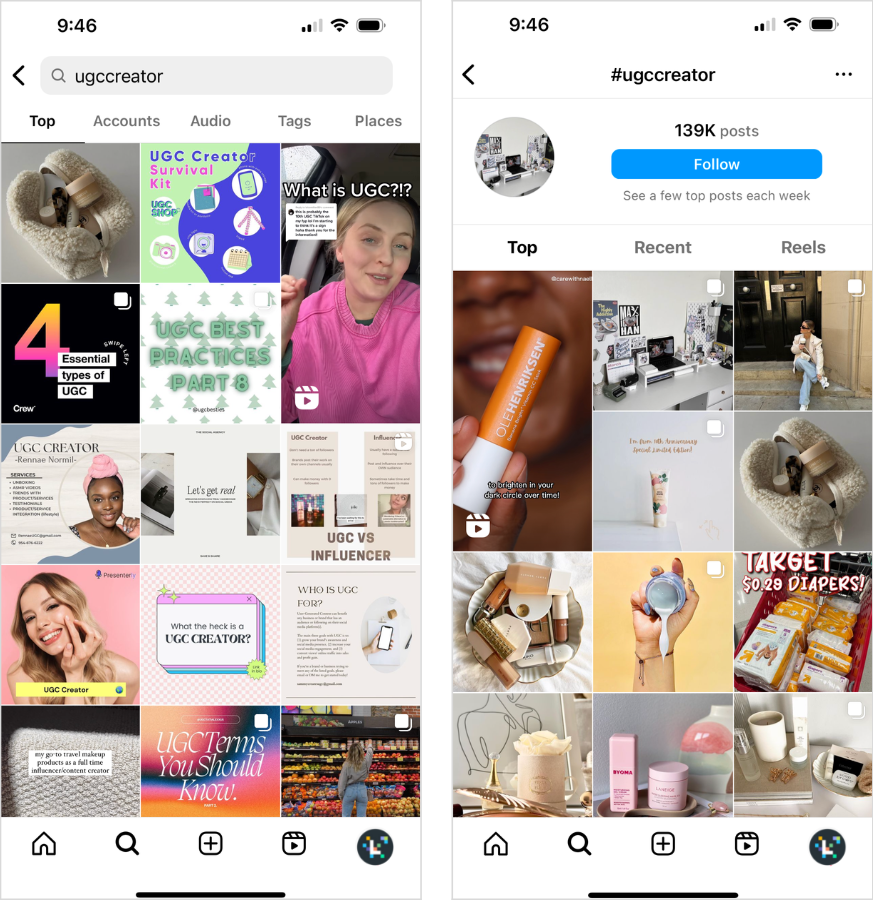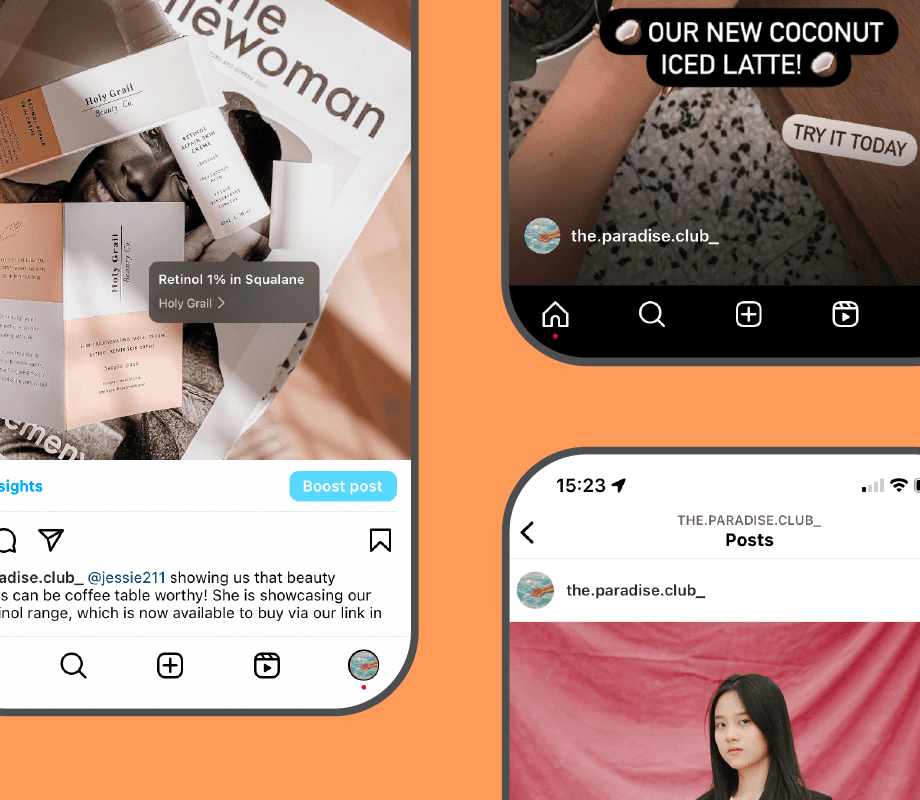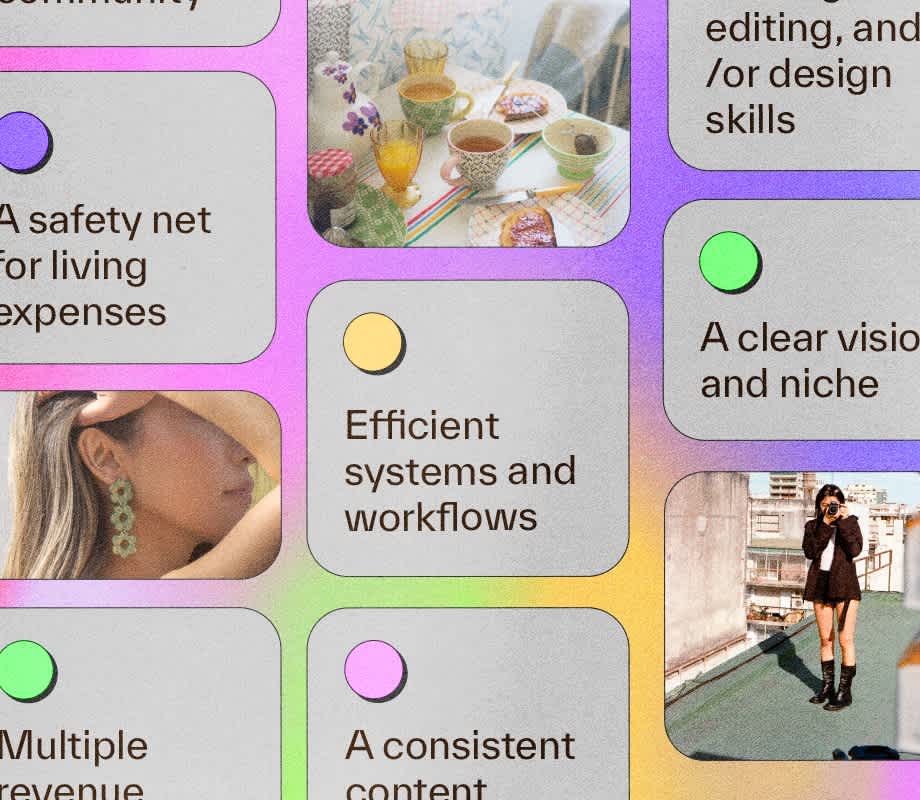If you’ve spotted the term “UGC creator” on your TikTok or Instagram feed, you’re not alone.
UGC creators are a new type of marketing tactic, changing how brands leverage traditional UGC.

So, what is a UGC creator, why are they valuable to brands, and how do you become one?
We’re breaking it all down, below.
Table of Contents
What Is a UGC Creator?
Historically, UGC (user-generated content) has been defined as content created organically by a brand’s followers or consumers — that is then shared by the brand on its own accounts:

Brands love UGC and for good reason — a 2021 study revealed that 80% of respondents said UGC highly impacts their purchasing decisions.
This is where the new “UGC creators” come in.
A UGC creator is a content creator who specifically creates content that looks like UGC — but it's been paid for.
“Unlike influencers who need to grow their community before they start working with brands, UGC creators don’t need tons of followers nor are they obligated to show their face.
They just have to create content that can be shared on the brand’s account,” says Later’s Social Content Lead, Lindsay Ashcraft.
“But it’s not technically organic — which is what UGC is. UGC has worked so well because it’s content created by real fans of a brand. A UGC creator is essentially just another term for freelance content creation,” adds Christine Colling, Later’s Social Media Manager.
Here at Later, our content marketing team defines UGC creators as:
Freelance content creators who specialize in creating UGC-inspired content for brands — whether it’s photos or videos.
In fact, we’ve paid creators — like Kayed Mohamed-Mason — to create content specifically for our social media accounts that resemble UGC:
“We started experimenting with this earlier in 2022 because we�’re a small team and needed more content. Instead of branded content, we commissioned videos from Kayed that seemed organic and similar to what we’d naturally post on our feed,” shares Christine.
Though, whatever you call it — UGC creator or freelance content creator — brands are paying for more “authentic” content to drive sales and traffic.
Psst, with Later’s management tools, you can schedule all of your social media content in advance. It’s the ultimate time-saver. Join over 4M brands, creators, and social media managers — sign up today:
Why Do Brands Love UGC Creators?
When brands use UGC as part of their marketing strategy, they’re not just selling products; they’re building relationships and driving conversion, too.
Let’s explore the benefits of using UGC creators:
Benefit #1: Builds A Bank of Content
Creating content is often a time-consuming process — especially for social media managers and entrepreneurs doing it all on their own.
UGC creators open the floodgates to a stream of content you didn’t have to create yourself.
You just have to brief the creators, and depending on the contract (and if it’s an ongoing partnership), you can receive multiple new deliverables on a monthly basis — win, win!
Another way to build your bank of UGC content - and develop a stunning influencer marketing strategy - is by collaborating with Later's Services team. See how they work with brands for *chef's kiss* content creation here.
Benefit #2: Builds Trust
UGC content has always been successful in building trust because it seems like a word-of-mouth recommendation from a friend or family member.
But not every brand has a big bank of UGC content at their fingertips.
By working with UGC creators, brands can post content that looks like UGC — typically less “glossy” or “branded” — to feel more organic, provide use cases, and ultimately, build trust.
It’s the perfect solution to showcasing your brand without seeming overly promotional or salesy.
Benefit #3: More Cost-effective Than Major Influencer Campaigns
Influencer campaigns are an important tactic for reaching new audiences, but depending on the type of creators you're working with (e.g. Macro, Mega), the money can add up.
This is especially true if it's going to be a one-and-done partnership for a timely launch or an event.
On the flip side, working with UGC creators on an ongoing basis lets you use their content across your channels, build your audience, and can keep costs from rising sky-high, too.
Benefits #4: Drives Sales
As we mentioned, UGC contributes significantly to conversion.
Because when users see real people using a brand’s product or service, they’re more likely to open their wallet:
Turns out, UGC creators have the unique ability to transform a product into a lifestyle, rather than just a one-time purchase.
Major score!
TIP: Sourcing and working with UGC creators is simple with Later's influencer marketing platform, Later Influence. Book a demo today to see how it works.
How to Become a UGC Creator
The rise of UGC creators opens the door for more people to create content (and get paid for it) regardless of their follower count.
However, it takes time, consistency, hard work, and a steady stream of income before you can claim full-time content creator status. So don’t quit your day job just yet.
Similar to anyone starting out in freelance content creation, here’s a step-by-step guide to becoming a UGC creator:
Identify Brands to Work With
Create Content
Build Your Portfolio
Sign up for Later
Tip #1: Identify the Type of Brands You Want to Work With
Before you start creating UGC, make a list of the brands you’d love to work with.
If that’s too niche, consider the industry you’d like to work in: Wellness? Fashion? B2B? Tech? Sports?
From there, spend some time auditing the content they already post:
What content seems to be working for them? What posts get the most comments or views?
Do they post a lot of UGC? If so, what does it look like?
What would draw your attention and make you stop scrolling?
Who is their target audience? What is their brand voice?
Are there any gaps in their content? Could they benefit from more Reels or TikTok tutorials?
Remember: UGC works well because it looks and feels authentic.
Working with brands in an industry that is of interest to you will make for a dream partnership and let your genuine connection with their product shine through.
Tip #2: Create Content — Practice Makes Perfect
Establish the type of content you want to specialize in — or whether you’ll be a generalist.
If you’d like to focus on images, it may be worth taking a few beginner photography courses. If you’re more comfortable on camera, create short-form videos that’d work well on Reels, TikTok, or Stories.
You can also practice on your own account. This will help you build your portfolio while experimenting with different features and content styles.
Tip #3: Create and Build Your Portfolio
Building a portfolio can help you pitch brands more effectively, highlight your work, and build long-term collaborations.
Some creators recommend using a Canva template to create a portfolio that explains who you are, why the brand needs UGC, and previous work (if you don’t have work yet, “create videos at home,” says creator @ugcang):
Once you're ready to pitch, send the brand's content or PR team an email.
Tools like HubSpot's email writer can help if you're stuck in a slump and don't know what to write.
If you’re not ready to pitch directly, you can search websites like Upwork, or even Twitter — which has tons of brands doing open calls looking for UGC creators:
Hey!!!!! I’m Looking for some UGC creators who is interested in a long term partnership,
— Skincare is a Lifestyle ✨ (@ashonteiam) August 28, 2022
making TikToks/ Instagram reels for my hair brand
Private message me with your pricing, availability, and portfolio. DMs are open 💕💕💕#UGCcontent #UGCcreator #hair
Tip #4: Sign up for Later
Here's a trick that makes it simple to start creating UGC content for some of the most-loved brands on the scene right now - joining Later's Influencer program.
That's right - it's free for creators to sign up for Later. You'll be added to our Influencer Database, making it easy for you to connect with brands that your audience will love.
What are you waiting for? Sign up today!
FYI: Later makes creators' earning potential easier with a customized link in bio page, content creation tools, and your personal best time to post. Create an account and get started today:
Frequently Asked Questions: UGC Creators
How Many Followers Do You Need to Become a UGC Creator?
UGC creators don't need a major following to land brand deals. In fact, your follower count doesn’t matter at all.
Why? Because most partnerships are content-only, meaning you’ll create content for brands without having to post on your own account.
How Do I Find UGC Opportunities?
There are plenty of platforms to get the search started. Check out these UGC services to help spark some UGC opportunities:
Twitter (search #UGCCreator and #UGCContent)
How Much Should I Charge as a UGC Creator?
In short: it depends.
There’s unfortunately no universal one-size-fits-all pricing rule.
UGC creator rates will vary based on a variety of factors including, the scope of work, time and resources required, number of deliverables and so much more.
That said, many creators typically adhere to a common formula: time spent on content X hourly rate.
Speaking of pay, Later's got a Creator Rates Report in the works. Sign up for our free weekly newsletter to be the first to know when it drops! 👀
Before you put all your eggs in one basket, it’s important to remember that good things take time, and becoming a successful UGC creator won’t happen overnight.
That said, if you’ve been interested in freelance content creation — UGC or otherwise — now is your time to shine.
And brands, if you’re looking to increase sales and reach new audiences, you’ve got some hiring on the horizon!
Ready to plan your social media content in advance? Start scheduling your posts with Later, the ultimate social media management platform — create an account for free.




